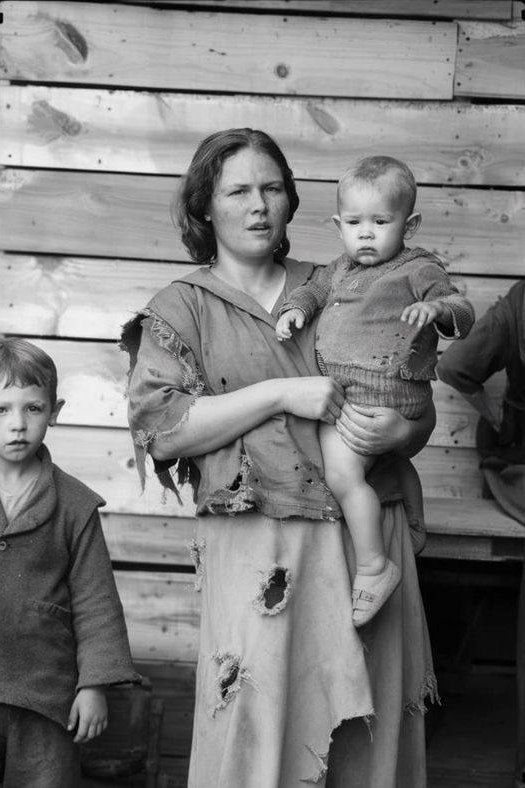In the sultry spring of 1936, near the rolling waters of the Tennessee River, a striking photograph was taken—a portrait that silently speaks volumes. It shows a woman—a mother—wrapped in a humble flour-sack dress, cradling her baby in her arms, surrounded by the sparse loneliness of a field along U.S. Route 70. She and her eight children were not posed for a studio shot; this was their living, breathing world, a daily existence transformed into a testament of resilience amid widespread deprivation.
Rural America, especially in the Tennessee Valley, was caught in a spiraling economic crisis. The Great Depression plunged families into a nightmare of unemployment, hunger, and relentless uncertainty. For many, even making ends meet required extraordinary creativity—turning flour sacks into clothing, patching worn boots until they held together, planting meager gardens wherever space allowed. And yet, in this image, what could so easily be assumed to be despair is tempered by something far more enduring: the quiet, unwavering determination of a mother determined to keep her family intact.
Nine Souls, One Shared Burden
This mother was one of nine—eight children looked to her for protection, nourishment, and hope. Living in a field beside U.S. Route 70, near the Tennessee River, meant exposure to the elements and isolation from what help might have existed in town. Yet the image doesn’t shout; it whispers. It whispers of exhaustion, yes—but also of love, resourcefulness, and a fierce commitment to family survival.

More Than a Photograph
This photograph resonates because it stands as a microcosm of a broader human story. The Dust Bowl, unemployment, homelessness, and hunger were headlines, yes—but for most Americans, the true story was told in living rooms and fields, around dinner tables and in storefront lines. One image like this can reopen the past, inviting us to walk a few steps in their worn-out shoes and to feel the raw humanity of an era often reduced to dates and statistics.
Why This Matters Today
Today’s world may look different, but the themes this image evokes—poverty, parental strength, family endurance—are forever relevant. It reminds us that even in our most comfortable moments, behind every simplified narrative of the past are real families, with dreams, fears, and the same vulnerabilities we all carry.
Echoes Through Time
Decades later, as the Tennessee Valley Authority (TVA) would bring electricity, flood control, and modernization to the region—transforming both the land and its people—the echoes of that image remind us what came before. Before dams, before electrified homes, there were fields like the one where this family lived. There were flour-sack apparel, bare feet weathered by hardship, and silent devotion illuminating a dark and difficult chapter of American history tn.govWikipedia.
So when you look at the photograph again, don’t just see the image. See the story—of struggle, ingenuity, familial love, and steadfastness in the face of overwhelming odds.